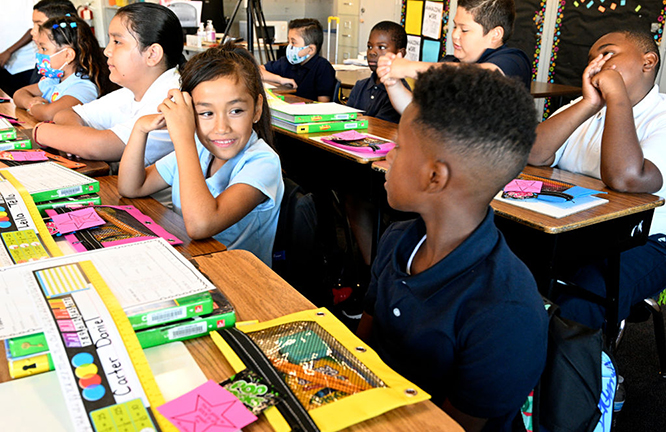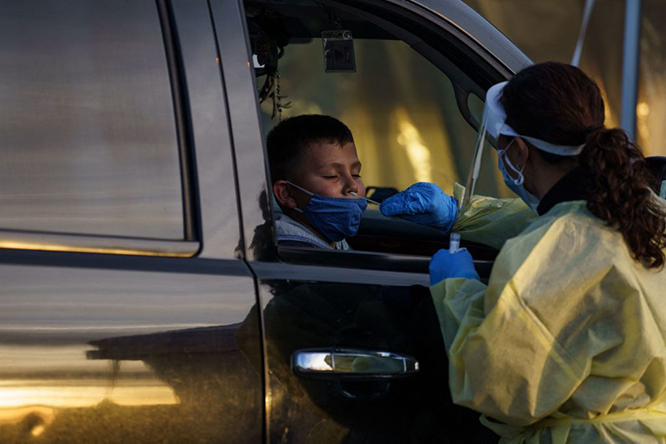COVID Brief: Students and Teachers Face Learning Loss as New Year Begins
A weekly roundup of headlines about how the pandemic is shaping schools and education policy, vetted by AEI Visiting Fellow John Bailey

Get stories like this delivered straight to your inbox. Sign up for The 74 Newsletter
This is our weekly briefing on the pandemic, vetted by John Bailey. Click here to see the full archive.
This Week’s Top Story

Schools Are Back and Confronting Severe Learning Losses
- “Learning loss generally is worse in districts that kept classes remote longer, with the effects most pronounced in high-poverty districts, researchers say. Yet reading scores are below 2019 levels for certain grades even in some states that quickly returned to in-person instruction, such as Florida.”
- “While some students have begun to make up ground, researchers say that, on average, it could take five years or more for today’s fourth-graders to read proficiently unless the pace accelerates.”
- “These students are at a pivotal stage. Educators pay particular attention to 9-year-olds’ literacy rates because research shows that reading ability by the end of third grade can be predictive of educational success, career earnings and the risk of incarceration.”
- Related: New Testing Data: Fewer Students in Early Grades Developing Basic Phonics Skills
The Big Three — September 16, 2022

What Researchers Know About COVID-19 and Children
- Very long piece in Science with briefs related to:
- Why is COVID-19 generally milder in children?
- Why do some children develop Multisystem Inflammatory Syndrome in Children (MIS-C)?
- Long COVID in children and young people
- What is the role of children in transmission of SARS-CoV-2?
- The importance of vaccinating children against COVID-19
- New must-read report from the Center on Reinventing Public Education (more at The 74 and EdWeek)
- Roadmap to Recovery
- Reporters’ Guide: Questions for assessing how your state or district is tracking pandemic impact and recovery
- “School district leaders, state policymakers and advocates can take important steps now to address students’ immediate needs and set the bar high for system transformation.”
- “Districts and states should immediately use their federal dollars to ensure every student in the COVID generation makes a full recovery. They must focus their resources on proven interventions, such as well-designed tutoring, extended learning time, credit recovery, additional mental-health support, college and career guidance, and mentoring.”
- “By the end of 2022-23, states and districts must commit to an honest accounting of rebuilding efforts by defining, adopting and reporting on their progress toward ambitious five- and 10-year goals for student recovery and reimagining. States should invest in rigorous studies that document, analyze and improve their approaches.”
Texas Telemedicine Program Allows Kids to See Therapists at School
- The Texas Child Mental Health Consortium was created to address a mental health crisis among young people in the state, many of whom lack access to care. It “is made up of medical schools and universities with health programs as well [as] other experts in the mental health field.”
- “Because of a shortage of mental health practitioners, many children are unable to get treatment or have to endure long wait times. In Central Texas, experts [say] that even with health insurance, children can expect to wait about six months before being seen.”
- “The overall span of the program has grown to encompass more than 3,000 schools across the state, reaching both urban and some rural areas.”
- School counselors can schedule the appointments and set up computers in their offices for children to attend their sessions.
City & State News
ARIZONA: A for Arizona launched the second round of the state Transportation Modernization Grants Program, a first-in-the-nation $20 million initiative to modernize transportation options and improve access to reliable and safe transportation for K-12 students.
MARYLAND: Gov. Larry Hogan announced a new $1.6 million grant program to provide additional support for nonpublic schools.
NEW JERSEY: Newark Public Schools drop mask requirement.
WASHINGTON: The Seattle Education Association reached a tentative agreement with Seattle Public Schools after a week-long strike.
Federal Updates
DEPARTMENT OF HEALTH AND HUMAN SERVICES: Issues nine-point checklist for school-based Medicaid services. More via K12 Dive.
- “While schools primarily provide education, school settings offer a ‘unique opportunity’ to enroll children and teens in Medicaid and the Children’s Health Insurance Program and provide Medicaid-covered services, including mental health services, said Daniel Tsai, deputy administrator and director of the Center for Medicaid and CHIP Services.”
- “The checklist includes a variety of recommendations for services and reimbursement management practices, as well as explanations and clarifications of existing rules.”
EDUCATION DEPARTMENT: Awarded the National Educational Technology Plan contract to the State Educational Technology Directors Association and its coalition partners: InnovateEDU, Learning Forward, Project Tomorrow and Whiteboard Advisers.
COVID-19 Research
One of Long COVID’s Worst Symptoms Is Also Its Most Misunderstood
- Ed Yong in The Atlantic.
- “Of long COVID’s many possible symptoms, brain fog ‘is by far one of the most disabling and destructive,’ Emma Ladds, a primary-care specialist from the University of Oxford, told me. It’s also among the most misunderstood. It wasn’t even included in the list of possible COVID symptoms when the coronavirus pandemic first began. But 20% to 30% of patients report brain fog three months after their initial infection, as do 65% to 85% of the long-haulers who stay sick for much longer.”
- “Most people with brain fog are not so severely affected and gradually improve with time. But even when people recover enough to work, they can struggle with minds that are less nimble than before.”
United Kingdom Rolls Back Vaccines for Kids Under 11
- “Children aged 5-11 will no longer be offered COVID jabs, except those in clinical risk groups.”
- “The decision to reduce the number of children who are offered COVID jabs has prompted outcry from parent groups and academics.”
- “The UK Health Security Agency said children who had not turned 5 by the end of last month would not be offered a vaccination, in line with advice published by the UK’s Joint Committee on Vaccination and Immunisation in February 2022.”
Viewpoints
Bloomberg: Pandemic Learning Loss Is a National Crisis
- Via Michael Bloomberg in The Washington Post
- “A closer look at the [NAEP] data reveals even greater reasons for alarm. Although white students performed five points worse in math than in 2020, scores fell by eight points among Latinos and by 13 for Black students. The gap between the best and worst scores also widened. … Put simply, the pandemic did the most harm to the children who could least afford it.”
- “Blame for these dismal results lies mostly with poorly designed and implemented remote instruction programs that stretched on far too long — and long after vaccines became available — largely because leaders of public school teachers unions wrongly insisted that requiring teachers to return to work endangered their safety.”
- “President Joe Biden can be doing far more to call public attention to the crisis and mobilize all levels of government to address it, including accelerating efforts to recruit and train tutors focused on highly vulnerable students.”
- “It’s also imperative that all students spend more time in class to help make up the lost ground. … School districts should use federal relief funds to increase instructional time, lengthen the academic year, expand summer-school slots and launch more ‘Saturday academies’ — preferably all of the above.”
The Pandemic Schooling Mode and Assessment Outcomes Data Series
- Via Emily Oster and the COVID-19 School Data Hub
- This series “explores how differences in access to full in-person instruction during the first full pandemic school year of 2020-21 relate to changes in student academic outcomes.”
- Oster’s twitter thread gives an overview:
- “Across 12 states with data released, we see universal test score declines from 2019 to 2021. Most states recover somewhat between 2021 and 2022. On average: states recover ~30% of losses between 2021 and 2022.”
Teacher Shortages a Reality as Schools Struggle to Fill New Positions
- “In rural Alabama’s Black Belt, there were no certified math teachers last year in Bullock County’s public middle school.”
- “Schools in the South are more likely to struggle with teacher vacancies. A federal survey found an average of 3.4 teaching vacancies per school as of this summer; that number was lowest in the West, with 2.7 vacancies on average, and highest in the South, with 4.2 vacancies.”
- “The school system in Moss Point, a small town near the Gulf Coast of Mississippi, has increased wages to entice more applicants. But other districts nearby have done the same. Some teachers realized they could make $30,000 more by working 30 minutes away in Mobile, Alabama.”
- Related via The 74: Yes, There’s a Shortage of Special Education Teachers. And That’s Nothing New
… And on a Lighter Note
Off to the Races: Focus on a different child every time you watch this.
Simple Enough: Run through the banner.
For even more COVID policy and education news, subscribe to John Bailey’s daily briefing via Substack.
Disclosure: John Bailey is an adviser to the Walton Family Foundation, which provides financial support to The 74.
Get stories like these delivered straight to your inbox. Sign up for The 74 Newsletter

;)
